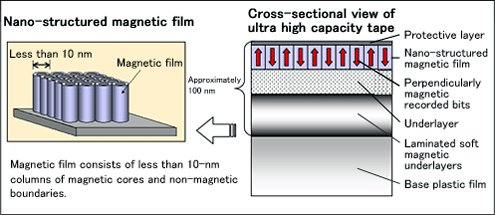This article is more than 1 year old
Hitachi Maxell demos 50TB capacity LTO-class tape
Perpendicular magnetic recording comes to tape
Hitachi Maxell has demonstrated a 50TB capacity LTO-class tape using perpendicular magnetic recording technology.
This is 400 per cent more than the raw capacity of the highest-capacity tape on the LTO roadmap, the 12.8TB LTO-8.
Hard disk drives have used perpendicular magnetic recording for some years and its limitations are now forecast to cause a transition to bit-patterned media or heat-assisted magnetic recording in a few years time.
The demonstration was a joint one by Hitachi Maxell and The Tokyo Institute of Technology. Hitachi Maxell says the current method of coating a tape's base layer with powdered magnetic grains faces difficulties in getting down to 10nm or less grain diameter, whereas that is possible using a "Facing Targets Sputtering" technology from the Tokyo Institute.

What happens in a sputtering process is that atoms are ejected from a solid material and form a thin film on the surface of a substrate.
We're told that this sputtering is done "at room temperature without a substrate cooling system. Fine composite films, which couldn’t be prepared by previously used magnetron sputtering methods, can be formed by facing targets sputtering, thanks to damage-less formation of films on a very thin plastic film with separated plasma from the film."
The tape was given a low-noise, laminated soft magnetic underlayer. The recording layer was then sputtered onto that to create a linear formatted perpendicular magnetic recording medium, a super-high density, nanometer-sized magnetic film with an areal density of up to 45Gbit/sq in. Applying this density to an LTO-5 size tape, in terms of width and length, results in a greater than 50TB capacity.
That capacity is 33 times greater than the raw capacity of LTO-5 tape, 1.4TB.
The total thickness of the recording layer, protective layer and underlayers is about 100nm.
The facing targets sputtering method was developed by associate professor Shigeki Nakagawa et al in the department of physical electronics, part of the graduate school of engineering at the Tokyo Institute.
What this means is that, in theory, the way is clear to use current physical-size LTO tape reels, and hence cartridges, as the LTO roadmap progresses. At some point there will likely be a switch from coated media to perpendicularly recorded media and at that point backwards compatibility, a feature of LTO technology, will be tested, as the drive heads will have to be able to read both types of media for backwards compatibility to work. ®
